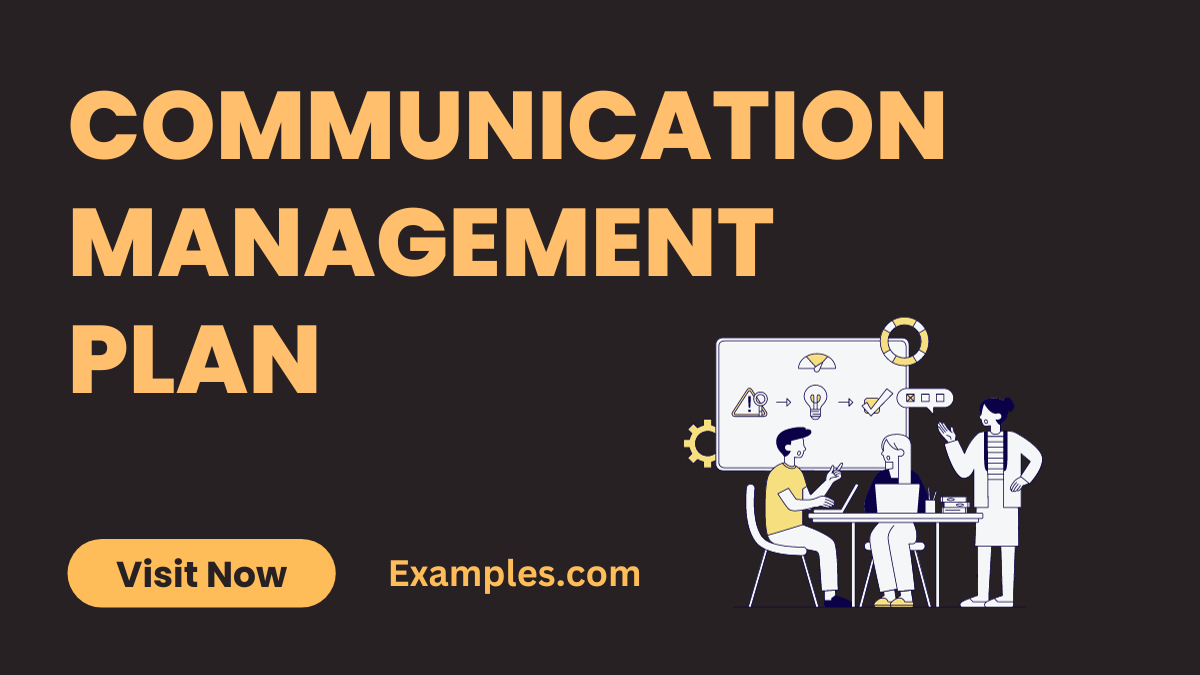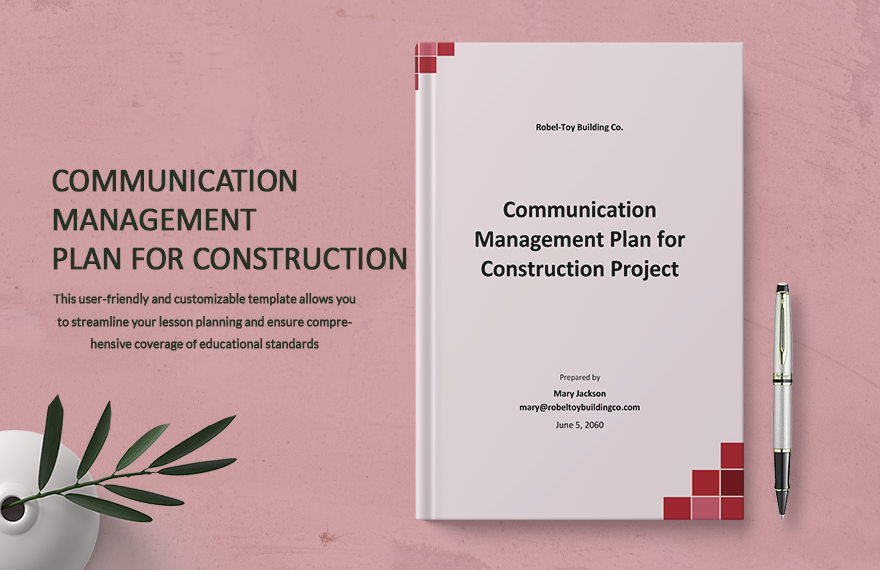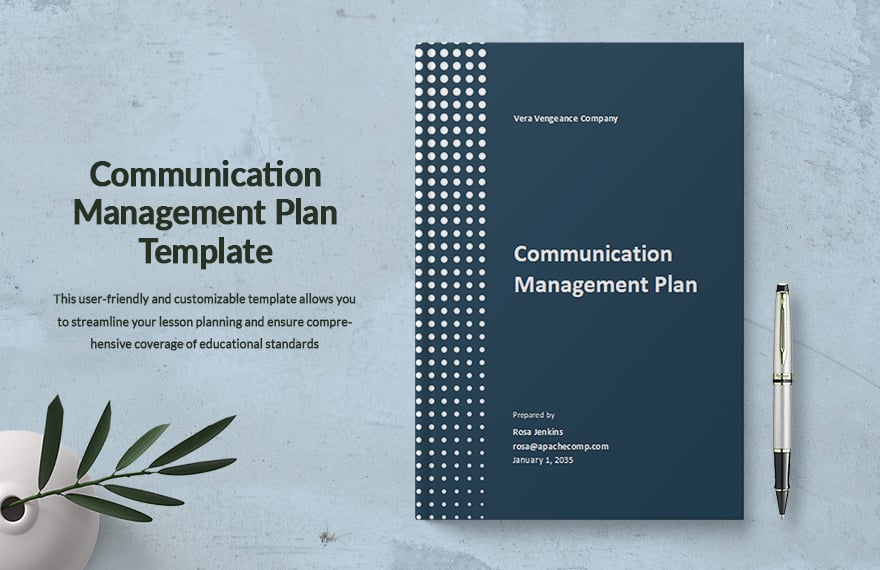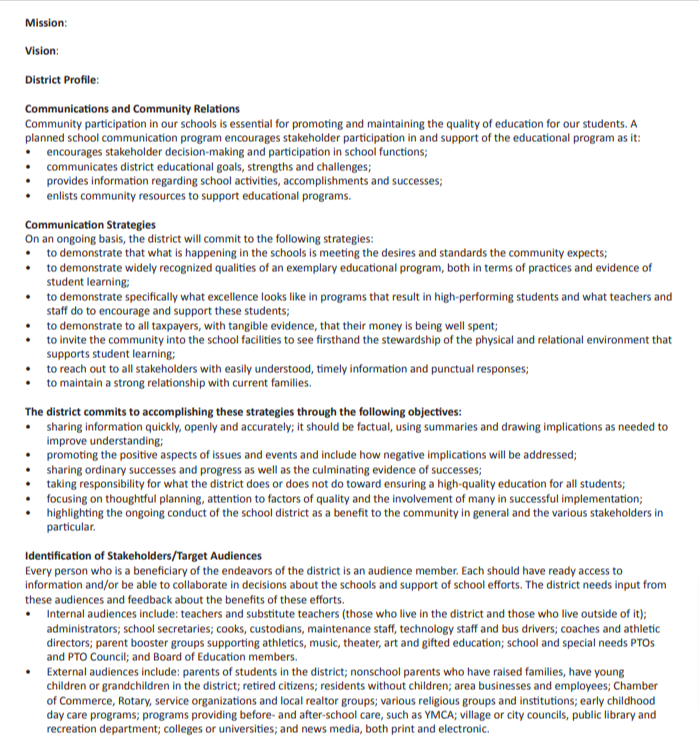11+ Communication Management Plan Examples
Discover the ultimate guide to mastering communication in project management with our comprehensive Communication Management Plan. This guide is packed with practical strategies, innovative approaches, and real-world “Communication Examples” to elevate your team’s interaction and project success. Whether you’re a seasoned professional or new to the field, our expert insights and examples will empower you to create a robust, effective communication framework tailored to your unique needs. Dive in and transform the way you connect, collaborate, and succeed in any project environment.
Download Communication Management Plan Bundle
Communication Management Plan
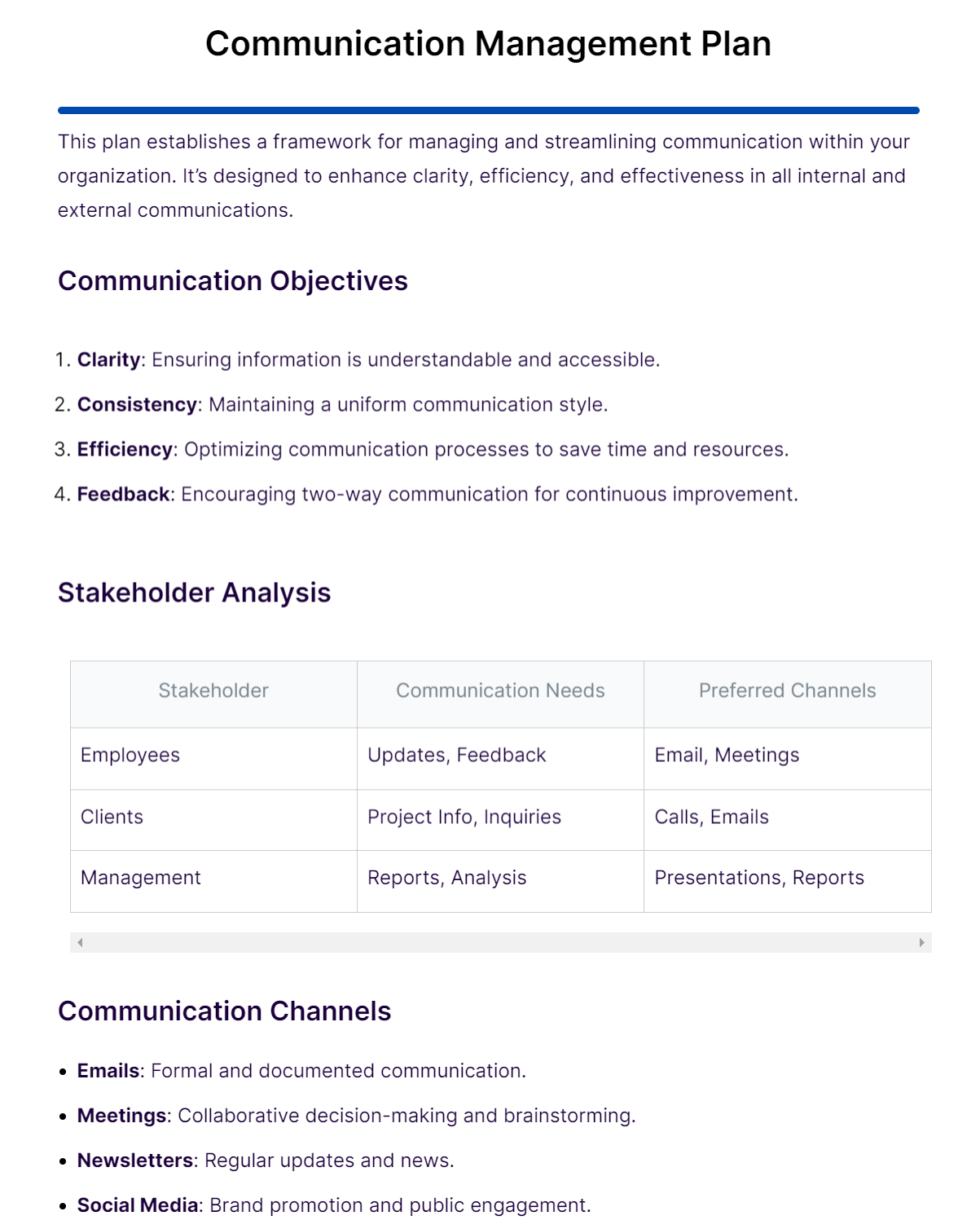
The Communication Management Plan provides a detailed framework for enhancing communication within organizations. It outlines objectives for clarity, consistency, efficiency, and feedback, and includes stakeholder analysis, various communication channels, a comprehensive communication matrix, and strategies for monitoring and feedback. This plan is designed to ensure cohesive and effective communication strategies tailored to the evolving needs of stakeholders.
Communication Management Plan in Marketing
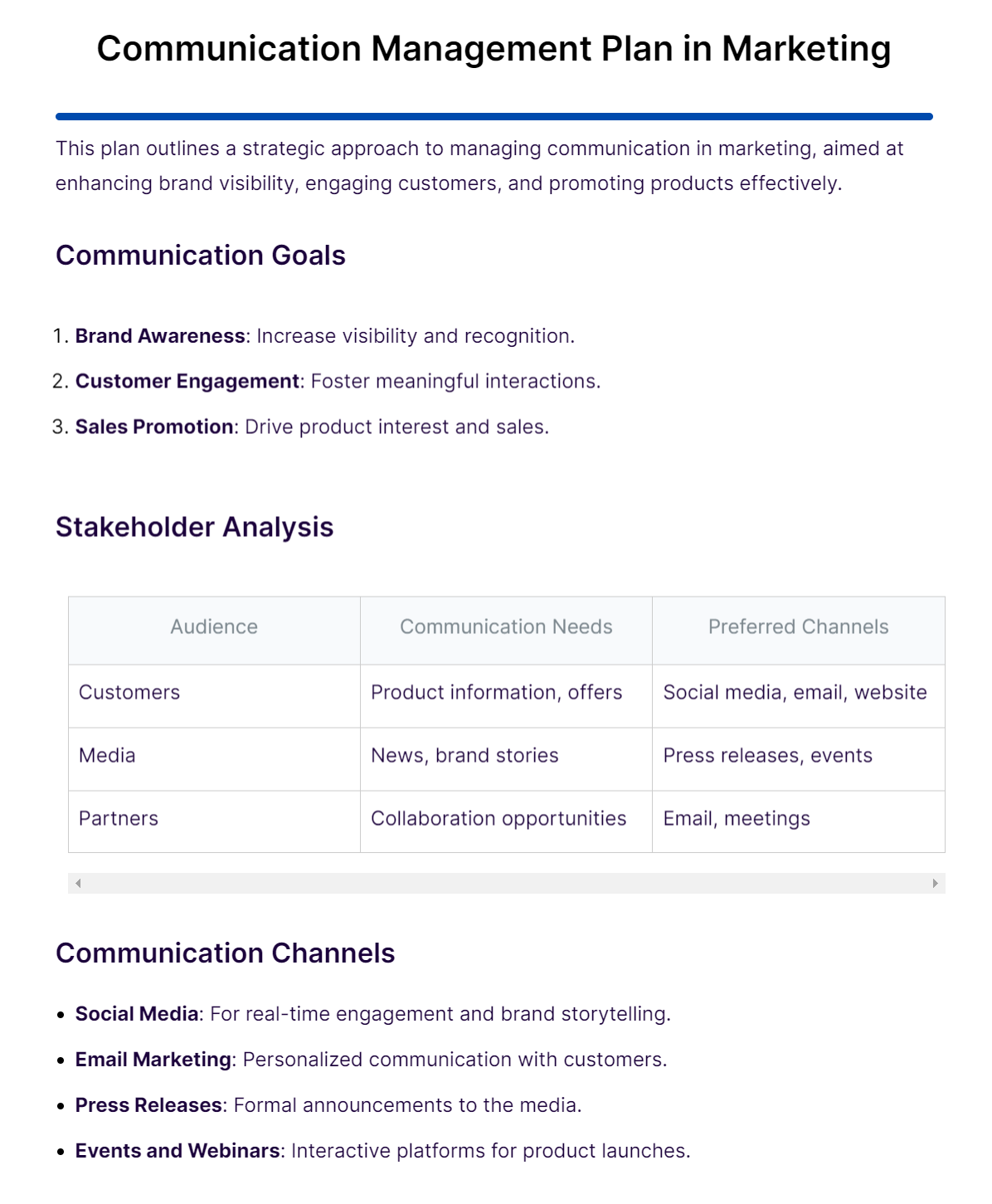
The Communication Management Plan in Marketing provides a detailed strategy for managing marketing communications. It focuses on enhancing brand visibility, engaging customers, and effectively promoting products. Key elements include setting communication goals like increasing brand awareness, fostering customer engagement, and driving sales. The plan also covers stakeholder analysis, identifying the preferred communication channels for different audiences, and outlines various communication channels like social media, email marketing, and press releases. Additionally, it includes a communication matrix, tools for monitoring and feedback, and budget allocation for activities like social media ads and PR events.
Program Management Communication Plan
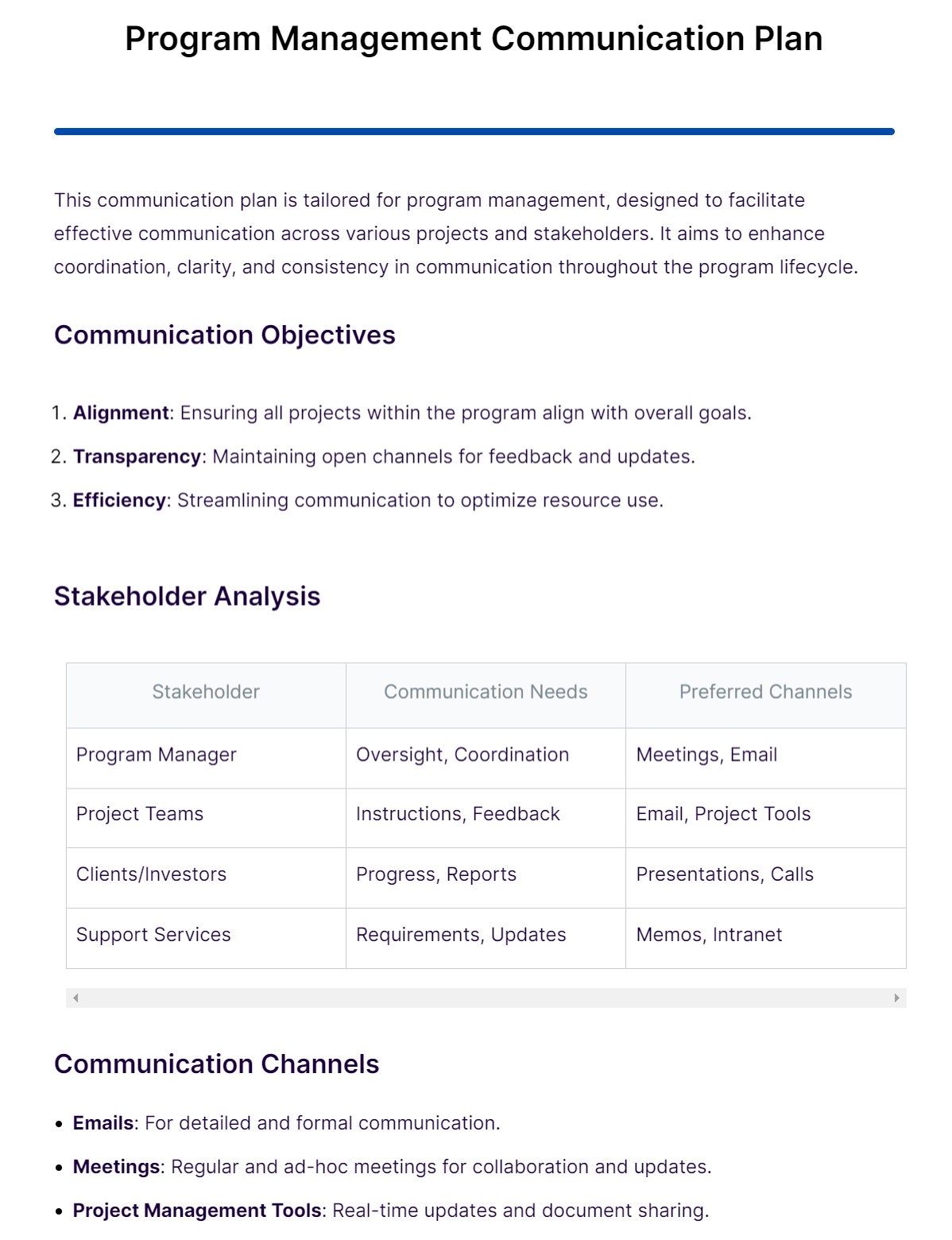
The Program Management Communication Plan outlines a comprehensive aiming to enhance coordination and clarity across projects. It focuses on aligning projects with goals, maintaining transparency, and optimizing efficiency. It details stakeholder needs, communication channels, and a matrix for structured updates. Regular feedback and reviews ensure the plan’s effectiveness and adaptability
Communication Management Plan in Project Management
The Communication Management Plan in Project Management detailed guide for ensuring effective communication throughout a project’s lifecycle. It outlines objectives, identifies stakeholders, and describes various communication methods and tools. The plan includes a communication matrix, meeting schedules, and strategies for documentation, feedback, and adapting to emergencies, making it a dynamic and essential resource for successful project management
Stakeholder Communication Management Plan
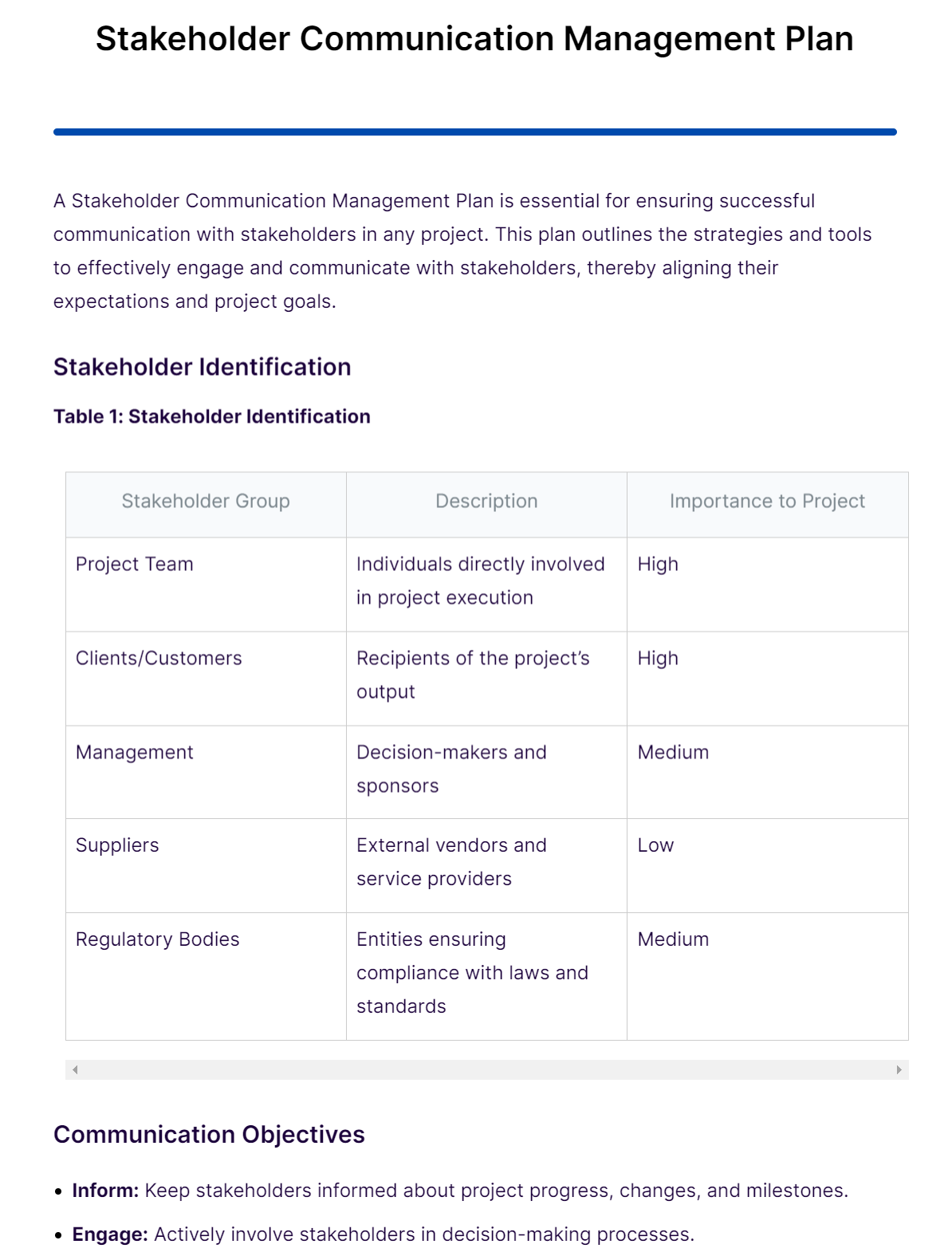
The Stakeholder Communication Management Plan is comprehensive guide for effective communication with stakeholders in any project. It outlines strategies and tools for engaging stakeholders, aligning their expectations with project goals, and ensuring successful project execution. The plan includes identifying stakeholders, setting communication objectives, utilizing various tools and channels, scheduling activities, and adapting based on feedback to maintain transparency and project alignment.
Event Communication Management Plan
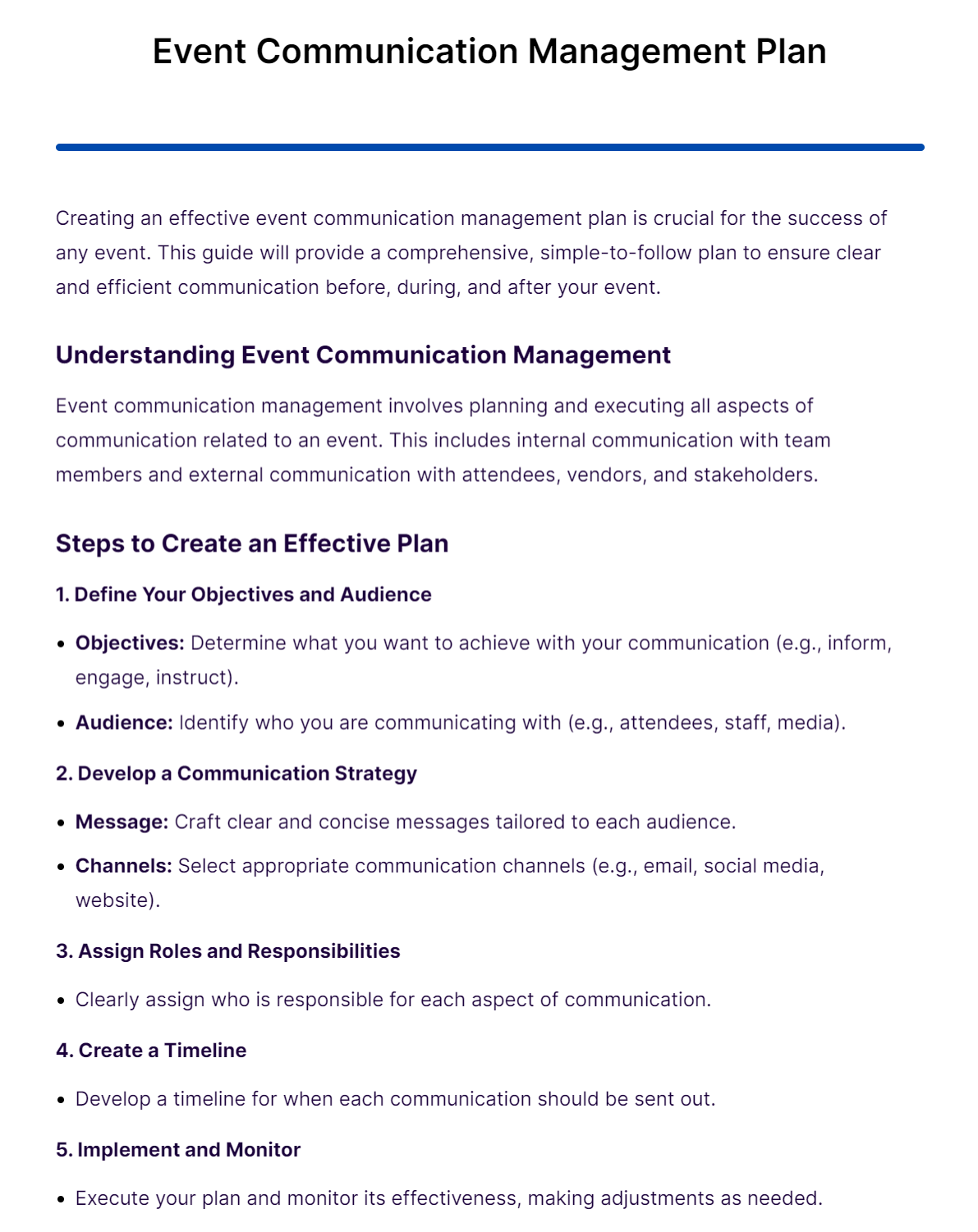
The Event Communication Management Plan is strategy for ensuring effective communication before, during, and after an event. It includes steps for defining objectives, developing strategies, assigning roles, and creating timelines, ensuring all stakeholders are informed and engaged. This comprehensive plan is designed to facilitate clear and efficient communication, contributing to the overall success of any event
Project Management Communication Plan
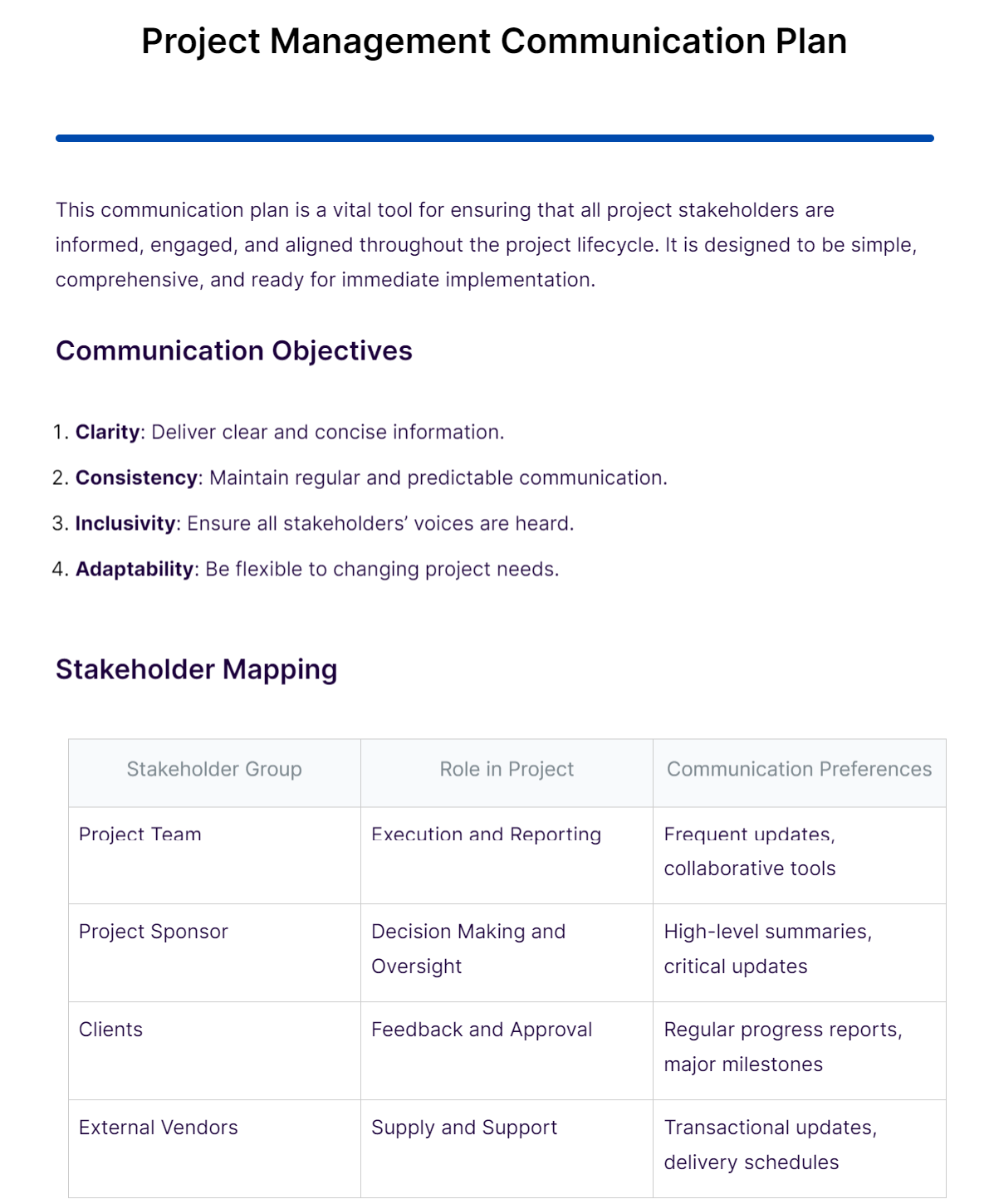
The Project Management Communication Plan is a comprehensive resource designed to ensure that all stakeholders in a project are well-informed, engaged, and aligned throughout its lifecycle. This plan is simple, thorough, and ready for immediate implementation, covering aspects such as clarity, consistency, inclusivity, and adaptability in communication. It includes detailed sections on stakeholder mapping, communication channels, schedules, feedback mechanisms, escalation protocols, and documentation. This guide is adaptable to various project sizes and types, emphasizing the importance of regular evaluation and adjustment of the communication process.
Communication and Change Management Plan
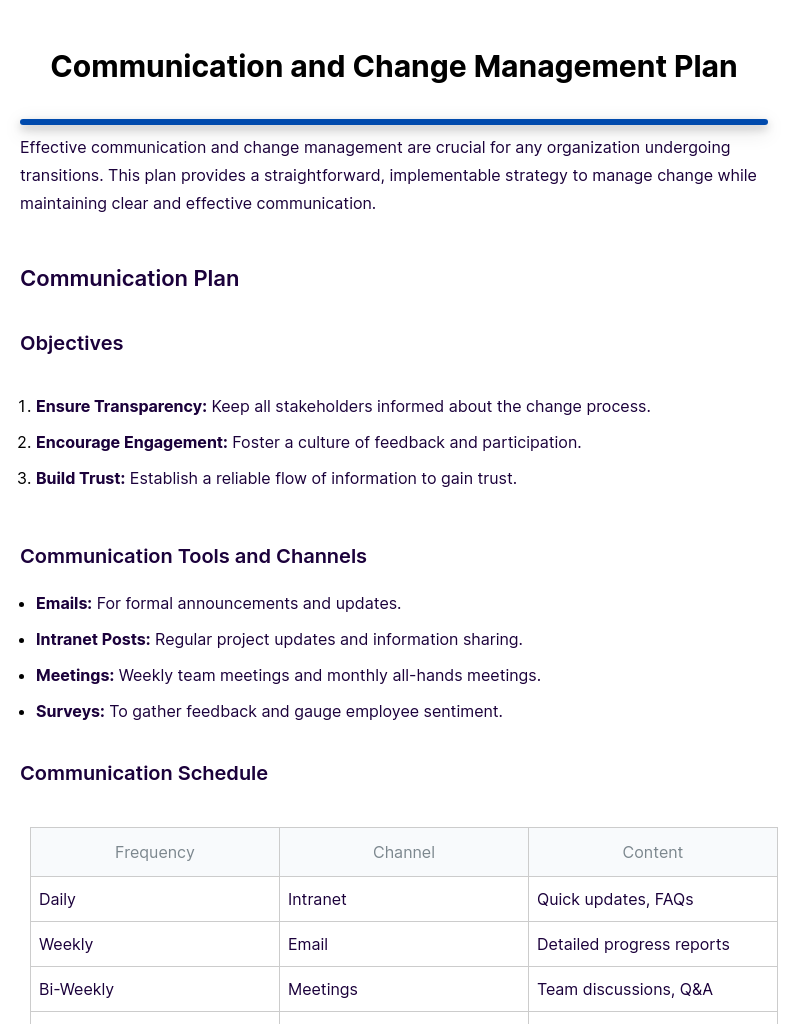
Classroom Communication Management Plan

The Classroom Communication Management Plan for enhancing learning environments. It outlines strategies for effective teacher-student-parent interactions, covering objectives, communication channels, key strategies, and roles. The plan emphasizes clarity, respect, and privacy in communications and provides a timeline for implementation, aiming to foster a positive and productive learning atmosphere.
Agile Project Management Communication Plan
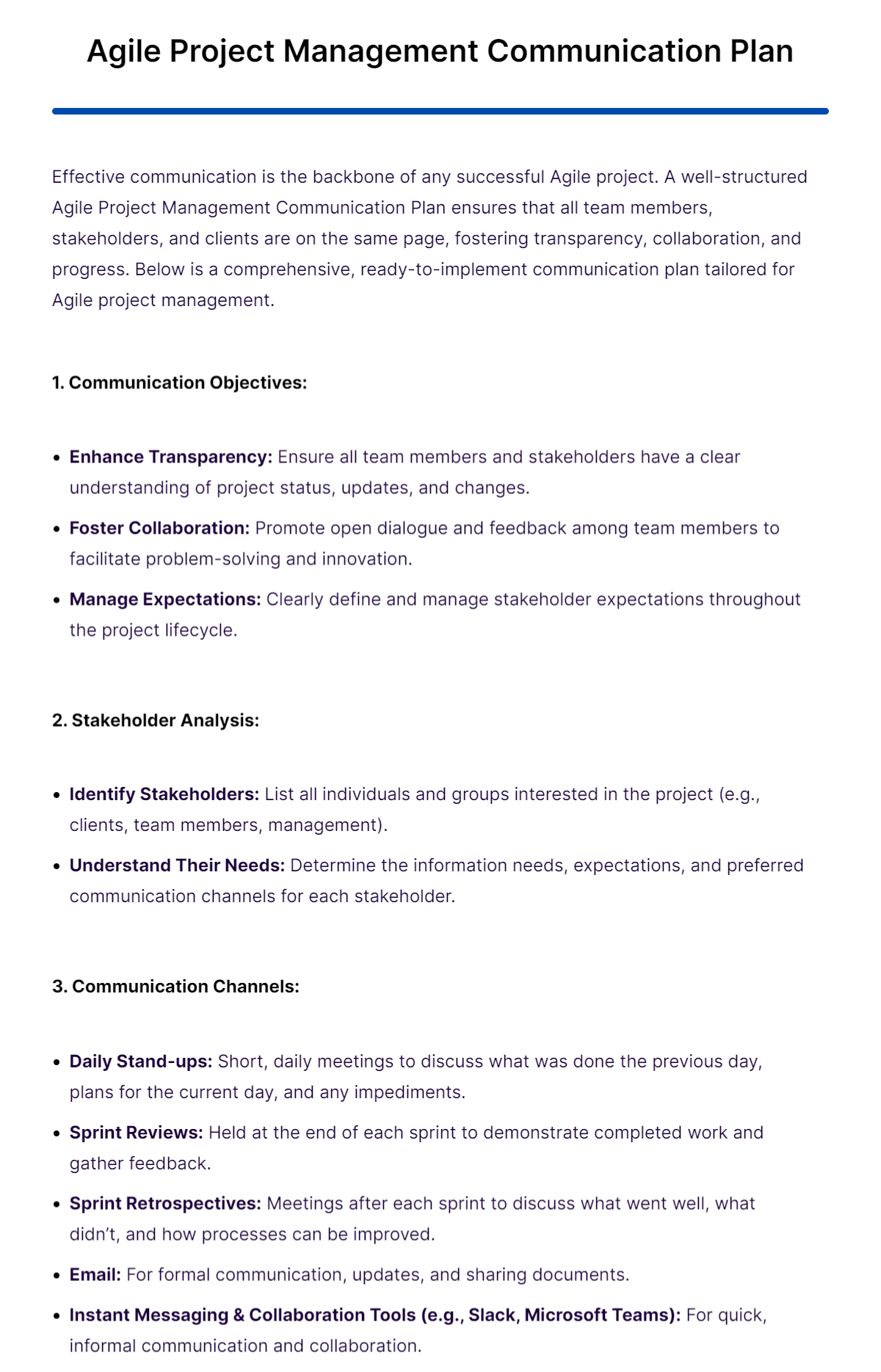
The Agile Project Management Communication Plan designed to enhance project success through effective communication. It outlines strategies for fostering transparency, collaboration, and managing expectations among team members and stakeholders. The plan includes stakeholder analysis, communication channels like daily stand-ups, sprint reviews, and various tools for information distribution, feedback, and adjustment. It’s a comprehensive resource for maintaining informed, engaged teams ready to tackle project challenges
Communication Management Plan for Construction Project Template
Communication Management Plan Template in Word
Community Relations Communication Management Plan
ohioschoolboards.org
DownloadCrisis Communication Management Plan
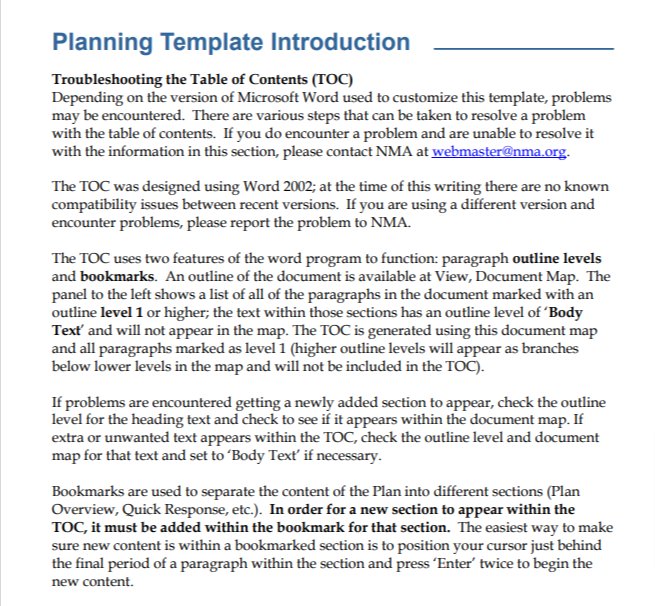
nma.org
DownloadPurpose of Communication Management Plan
The Purpose of a Communication Management Plan is to streamline and clarify the exchange of information among project stakeholders, mitigating Miscommunication in Couples and Non-Verbal Misunderstandings. It addresses Conflict Avoidance, fosters Trust Erosion recovery, and supports transparent dialogue, crucial in Marriage and professional settings. By setting clear communication protocols, it aims to prevent Relationship Breakdown and enhance collaborative success.
- To Define Roles and Responsibilities:
Example: In our team meetings, we clearly state who is responsible for what tasks to avoid any Expressive Barriers.
This ensures everyone knows their role, reducing confusion and enhancing accountability. - To Set Expectations for Communication Frequency:
Example: We agree to weekly check-ins to prevent any Trust Erosion and keep all team members updated.
Regular updates maintain transparency and ensure ongoing alignment. - To Establish Channels for Feedback:
Example: Our project includes an anonymous suggestion box to address Intimacy Challenges and encourage honest feedback.
This promotes a culture of open communication and continuous improvement. - To Identify Key Messages:
Example: In our briefings, we always highlight the critical points to reduce Miscommunication in Couples.
This ensures that all parties understand the primary objectives and information. - To Plan for Crisis Communication:
Example: We have a predefined emergency contact list to quickly address and mitigate any Conflict Avoidance issues.
Being prepared for crises ensures that they are handled efficiently and effectively. - To Enhance Relationship Building:
Example: We schedule regular team-building exercises to overcome Emotional Disconnection and strengthen bonds.
Fostering positive relationships is key to a productive and harmonious environment. - To Promote Understanding Across Diverse Teams:
Example: Our multicultural team uses translation tools to prevent Non-Verbal Misunderstandings during discussions.
Acknowledging and addressing cultural differences is crucial for effective communication. - To Provide a Reference for Communication Standards:
Example: Our communication guide outlines expected behaviors to avoid any Blame and Poor Communication scenarios.
Clear standards help maintain professionalism and respect among team members. - To Align Communication with Project Goals:
Example: Each update aligns with our roadmap, ensuring we don’t deviate due to Partner Detachment.
Aligning communication with objectives keeps the project on track and focused. - To Encourage Continuous Feedback and Adaptation:
Example: We hold retrospective meetings to address any Expressive Barriers and adapt our strategies accordingly.
Adapting to feedback is essential for growth and improvement in any endeavor.
How To Create an Effective Communication Management Plan?
Creating an effective Communication Management Plan is essential for maintaining clarity, coherence, and efficiency in various environments, be it in personal relationships, workplaces, or formal projects. This guide will walk you through the steps to devise a plan that addresses common communication challenges, such as miscommunication in couples, conflict avoidance, or interpersonal silence, and enhances the overall communication process.
- Identify the Communication Needs and Challenges: Start by identifying the specific needs and challenges in your communication environment. This might include expressive barriers in personal relationships, poor communication in teams, or non-verbal misunderstandings in multicultural settings. Understanding these aspects is crucial for tailoring your plan effectively.
- Engage Stakeholders in the Planning Process: In a professional setting, involve team members, managers, and other stakeholders in the planning process. For personal relationships, this might involve open discussions with your partner about intimacy challenges or emotional disconnection. Participation ensures that the plan addresses everyone’s needs and perspectives.
- Set Clear Goals and Objectives: Define what you aim to achieve with your Communication Management Plan. Goals could range from improving trust erosion in personal relationships to enhancing team efficiency in the workplace. Ensure these goals are specific, measurable, achievable, relevant, and time-bound (SMART).
- Choose Appropriate Communication Tools and Channels: Select tools and channels that best fit the communication needs of your environment. This could include digital tools for remote teams, face-to-face meetings for personal discussions, or specific strategies to overcome expressive barriers.
- Develop a Feedback Mechanism: Establish a system for feedback to continually improve communication. This could be regular check-ins in a relationship to address relationship breakdown or employee surveys in a workplace. Feedback is essential for addressing issues like conflict avoidance and adapting the plan as needed.
- Implement Training and Development Programs: For professional environments, provide training and development programs to enhance communication skills. This could include workshops on active listening, conflict resolution, or dealing with poor communication.
- Regularly Review and Update the Plan: A Communication Management Plan should be dynamic. Regularly review and update it to reflect changes in the communication environment, be it in a new relationship or a changing team dynamic in the workplace. This ensures the plan remains effective and relevant.
What are the Components of Communication Management Plan?
A Communication Management Plan is a critical aspect of project and relationship management, ensuring that all parties are aligned and informed. This guide will explore the essential components that make an effective plan, optimized for understanding and implementing a robust Communication Management Plan.
1. Purpose and Objectives: Begin by defining the purpose and objectives of your Communication Management Plan. This sets the foundation and direction for all communication activities and ensures every action is goal-oriented, addressing both Emotional Disconnection and Trust Erosion issues in relationships or projects.
2. Stakeholder Analysis: Identify and analyze the stakeholders involved. Understanding who needs to be in the loop and their impact on the communication dynamics is vital. This helps in addressing potential areas like Non-Verbal Misunderstandings and Relationship Breakdown by tailoring the communication to their needs and expectations.
3. Information Distribution Methods: Outline the methods and channels for information distribution. Whether it’s meetings, emails, or reports, choosing the right method is crucial for avoiding Examples of Miscommunication in Couples or teams. It’s about ensuring that the message is not just sent but also received and understood.
4. Frequency and Timing: Determine how often and when communication will occur. Regular updates might be necessary in situations prone to Conflict Avoidance or when addressing Intimacy Challenges. Consistency in communication frequency helps in maintaining clarity and avoiding Partner Detachment.
5. Responsible Parties: Specify who is responsible for communicating information. Assigning clear roles prevents Expressive Barriers and ensures that everyone knows who to turn to for updates or clarifications, ultimately reducing the Blame game in scenarios of Bad Communication.
6. Feedback and Adjustment Mechanisms: Establish a system for receiving and integrating feedback. This is crucial for continuous improvement and addressing issues like Poor Communication early on. A feedback loop encourages openness and can significantly help in Marriage or team dynamics.
7. Escalation Processes: Define the escalation process for when communication fails or when critical issues arise. Knowing how to escalate and resolve issues is vital for preventing Separation or project failure due to unresolved disputes or misunderstandings.
8. Glossary of Terms: Include a glossary of key terms and jargon. This is particularly important in complex projects or relationships where Non-Verbal Communication Misunderstandings can lead to significant issues. A common understanding of terms promotes clarity and understanding.
9. Review and Updates: Outline how and when the plan will be reviewed and updated. As relationships or projects evolve, so too should your Communication Management Plan, adapting to new challenges like New Relationship dynamics or project scope changes.
As we conclude this comprehensive exploration of Communication Management Plans on it’s clear that such plans are not just about facilitating transactions of words but about building bridges of understanding. They are the backbone of successful projects, fostering environments where ideas thrive, and misunderstandings shrink. To further your journey in mastering effective communication, explore the in-depth insights provided by the USC Annenberg School for Communication and Journalism, which offers valuable knowledge on the latest strategies and tools in communication management.


